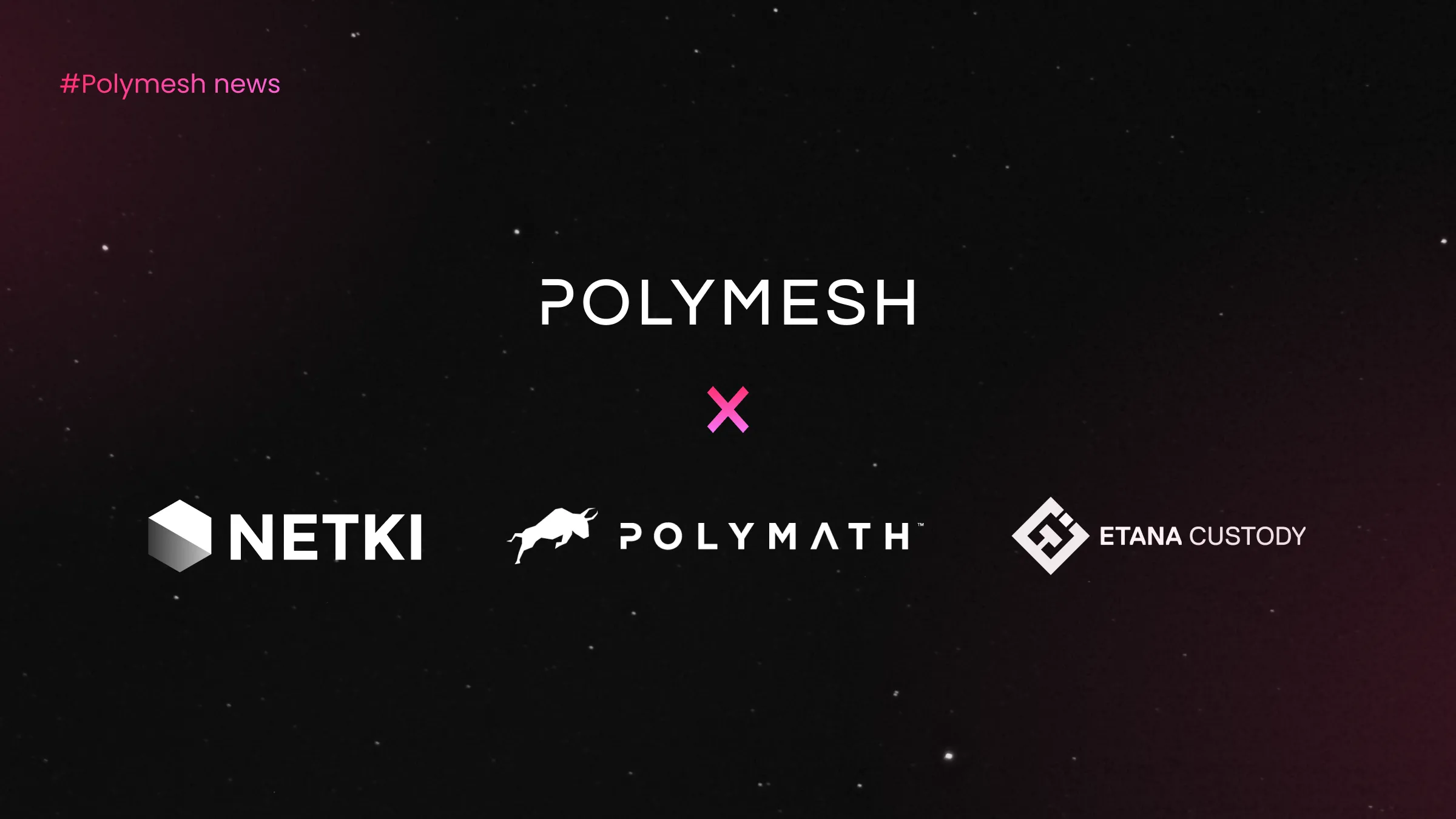Understanding governance on Polymesh
Polymesh’s new integration with the Polkasembly Governance Block Explorer is your gateway to Polymesh governance, which is designed to be transparent, decentralized, and community-driven. This brand new interface would also benefit greatly from intense user testing. Let us know of any bugs or improvements you see!
Any POLYX token holder who has onboarded to Polymesh can use the new governance block explorer to submit proposals for changes and updates to the network or to vote on proposals submitted by others.
But first, it’s important to have a solid grasp of blockchain governance and how it works on the Polymesh blockchain.
This masterpost on Polymesh governance will teach you everything you need to know about blockchain governance, including:
- What blockchain governance is
- Why blockchain governance is important
- The differences between on-chain and off-chain governance models
- The challenges of off-chain governance
- The benefits of on-chain governance
- How governance works on the Polymesh blockchain
- Best practices for creating Polymesh Improvement Proposals (PIPs)
- How to get started with Polymesh governance
Ready to learn? Let’s go!
What is blockchain governance?
Blockchain governance describes the rules, process management, and decision-making system that influence the direction of the network and how changes are implemented.
Effective blockchain governance is an integral part of ensuring efficiency in the underlying protocol and promoting ecosystem development.
Blockchain governance comes in many different forms. Whatever model is used defines the network’s level of decentralization, fairness, and balance of various interests across stakeholders.
Why is blockchain governance needed?
Blockchain networks should be fluid; it should be possible to upgrade the code base to add or remove features as participants’ needs change or technology improves.
For public blockchains, making these changes isn’t easy. Even though a few individuals might maintain and work on the core technology (like the Polymesh Association, which is responsible for maintaining Polymesh), there are vast numbers of participants who derive value from the blockchain and will be affected by its changes.
Just like how node operators need to reach consensus in the validation of new blocks, public blockchains require consensus across the network to change any rules and processes. But it can be hard to find consensus with so many different stakeholders, especially when users, core developers, node operators, and stakers can have conflicting interests.
This is where blockchain interweaves with game theory, which explores how rational agents make strategic decisions about their best interests in different scenarios, given the known preferences of others.
A major factor of decision-making in blockchain is the governance model, which dictates the process of finding consensus between stakeholders as well as how decisions are implemented on-chain.
Blockchain and decentralized governance
In a centralized network, governance is easy: decision-making is within the power of the centralized authority.
As decentralized distributed ledgers, public blockchains instead have to rely on innovative governance systems to ensure their longevity and the real-world use of the network. These governance mechanisms help to execute essential decisions like running upgrades, exacting irreversible hard forks, or adjusting the network’s tokenomics.
Blockchain governance is also key to resolving disputes between decentralized parties in a fair and inclusive manner.
While the ideal is a fully decentralized governance model, new blockchains may rely on elements of centralized governance while the ecosystem is in its infancy. For example, Polymesh currently relies on the Governing Council, a key group of stakeholders who have ultimate veto power over proposals. The Governing Council plays a key role in quicker decision-making and ensuring the blockchain’s survival, but could be abolished in the future once the network grows to reach sufficient decentralization.
The importance of governance for security tokens
Governance is a tricky topic for any blockchain, but it’s especially important for a blockchain on which participants issue security tokens, where the chain is not only the source of truth for potentially billions of dollars but must also allow compliance with regulation.
Establishing effective blockchain governance for security tokens is challenging given that the technological and regulatory environment is expected to evolve. At the moment, there’s little legal or regulatory certainty around the relevant state of security tokens for situations such as hard forks.
When more than one copy of the ledger exists, significant problems arise for regulation, reporting, and tax treatment because an asset is now represented on more than one chain. Who decides which issuance of a security token retains the underlying claim if a blockchain has forked? How should issuers, investors, and service providers decide which fork to support? These kinds of questions are highly disconcerting for participants dealing with regulated securities.
Capital market participants and regulators are unlikely to accept this uncertainty. Luckily, technological innovation can lead to increased clarity.
As you’ll see below, Polymesh has a forkless architecture that ensures there is always one canonical verison of the chain that issuers, investors and service providers can rely on to bring stability to their operations.
On-chain vs. off-chain governance
Blockchain governance can be either on-chain or off-chain.
Off-chain governance is when decision-making happens informally off-chain via discussion, with updates then proposed for implementation to the blockchain’s underlying code base.
Off-chain governance is the model that most resembles real-world politics. Ethereum and Bitcoin are two examples of blockchains with off-chain governance.
In contrast, on-chain governance is when decision-making happens on the blockchain, with participants voting with native tokens to make changes to the blockchain directly.
On-chain governance gives its participants a greater say in how the network evolves and ensures that voting results are binding. It’s a common governance model for blockchain ecosystems that use proof-of-stake and, you guessed it, is used by the Polymesh blockchain!
Let’s take a closer look at each to understand the benefits of on-chain governance.
The challenges of off-chain governance
Off-chain governance models feature a number of ways for ecosystem stakeholders to collectively discuss and agree upon rules and updates. Common means are community forums, social media, the network’s official communication channels, mailing lists, and conferences.
Once agreement is reached, a protocol update will be submitted by core developers through formal improvement proposals and then submit to the official repository (usually on GitHub).
Off-chain governance systems are attractive because they don’t require a transaction fee to participate. The crux is that off-chain governance only functions well when various stakeholders come to a consensus, actually execute the relevant update, and do so in unison.
Without full consensus, the network is liable to split into two chains (known as hard forks), with each instance running a different version of the ledger from that point, as well as competing for brand and users. This is viewed as a zero-sum outcome by many and ultimately defeats blockchain’s ability to serve as a golden record of truth (not to mention, creates major legal and tax challenges for tokens backed by real assets).
Meanwhile, coming to a consensus and then implementing any changes can take a long time, especially as it’s possible to discuss a proposal indefinitely. Even when consensus is reached, a significant amount of coordination is required between all nodes running the blockchain’s software in order to avoid forking.
Further, whatever consensus is reached informally isn’t binding. As a result, off-chain models have a tendency to concentrate power in the hands of a few core developers and validators. This isn’t necessarily bad, but it can lead to a conservative approach to making changes and questions the fairness of the governance model.
Finally, it’s rare that individual users will have enough input to be influential in any changes. And with off-chain governance requiring participants to use certain channels to get involved, it can be hard for individual users to even know where to participate to begin with.
The benefits of on-chain governance
Polymesh uses on-chain governance, which offers benefits in terms of transparency, the provable inclusion of stakeholders, and on-chain coordination.
With on-chain governance, code changes and upgrades are encoded into the protocol and decided upon by voting directly on-chain. Typically you need to hold the blockchain’s native coin to participate in governance, with the weight of your vote determined by the number of coins you hold, transact, or in the case of Polymesh, bond to the proposal.
Usually it is token holders, core developers, and validators who will propose changes and vote on whether or not to integrate them. Like off-chain governance, well-functioning on-chain governance requires efficient and easy coordination between these various parties. To aid in this process, some governance systems borrow from off-chain models and encourage discussions about proposals in conferences, forums, or online spaces before they are voted upon.
Let’s now take a look at the main benefits of on-chain governance:
Binding code changes
Voting is directly recorded on the public ledger with results irrefutably implemented on-chain, ensuring that no change or reversal occurs with agreed upon proposals and preventing centralized powers from making changes at will
Faster implementation
Voting on-chain involves pre-defined voting thresholds and periods that facilitate quicker consensus, resulting in faster implementation of code changes compared to informal, off-chain mechanisms where issues can be debated indefinitely
Transparency in decision-making
The governance process including voting thresholds and periods is known to participants prior to voting and contains consistent consensus rules, eliminating the risk involved in trusting centralized powers to enact changes and increasing network support
Wide participation
As any token holder may vote on protocol changes, a greater group of people may participate in the governance process compared to off-chain systems, where discussions may not always be accessible and direct influence is restricted to core developers and validators
Fewer malicious hard forks in the chain
On-chain governance reduces the risk of chain splits or forks by improving consensus and giving developmental control to the community; moreover, stakeholders are more likely to accept changes if they feel enfranchised in the voting process
Individual user influence
By voting on-chain, individual token holders have a direct way to influence changes in the network and register their input, making decision-making more democratic than off-chain systems where a user’s voice can only be signalled through participation in community discussions
The governance process on the Polymesh blockchain
Polymesh governance is built into the core of the chain and comes to life in 2 key ways: Polymesh’s approach to upgrades and the blockchain’s industry-leading on-chain governance model.
These elements work together, with the underlying Substrate framework ultimately enabling seamless upgrades as well as the execution of chain management by users.
By enabling token holders and other stakeholders to participate in the decision-making process, Polymesh can be responsive to the needs of its users and capable of adapting to changing capital markets requirements.
Let’s take a look at each more closely to understand how Polymesh’s governance model mitigates the problems faced by off-chain models.
Forkless architecture with Substrate framework
Polymesh is built with the Substrate framework. Among Substrate’s many benefits are its Forkless Runtime Upgrades, which allow seamless upgrades on-chain without the risk of hard forks as well as the storing of chain governance information on the blockchain.
Forkless runtime upgrades are the key to Polymesh’s completely on-chain governance model.
Without getting into the technical details, forkless upgrades mean the ability to upgrade Polymesh is a feature of the blockchain itself, with any changes to the chain recorded directly on it. This ability is leveraged by users to create proposals and support proposed changes on the immutable ledger, and ultimately have a voice in chain management.
Let’s now take a look at the process for submitting a Polymesh Improvement Proposal (PIP)!
Polymesh Improvement Proposals (PIPs)
Any POLYX holder has an opportunity to influence the direction of the Polymesh blockchain by submitting a Polymesh Improvement Proposal (PIP) through Polymesh Governance, or by voting on a PIP created by others. PIPs submitted by token holders are sometimes called “community-submitted proposals”.
Once a PIP is submitted, it is assessed by the Governing Council to determine if it should be ratified, rejected, or temporarily skipped.
Community-submitted PIPs are curated in a list ordered by their importance to the community. The Governing Council will consider the list of PIPs in their curated order on a periodic basis.
Note that there is a limit to how many times the Governing Council can skip a particular PIP to ensure that community signaling remains relevant and considered.
PIPs can also be submitted by Committees (more on Committees below). The Governing Council is free to consider community-submitted PIPs in any order.
Take a look at the chart below to understand the flow of Polymesh governance.

A note on transparency
Transparency is a tricky topic when it comes to voting procedures. On Polymesh, transparency is limited to voting records, meaning one cannot know who voted for what, only the vote result as such.
Types of Polymesh Improvement Proposals (PIPs)
PIPs must be concrete, on-chain actions; areas relating to the off-chain realm cannot be addressed.
PIPs can represent any change to the network, from adjusting protocol fees to permissioning certain on-chain identities with special roles (Polymesh is a permissioned blockchain, and requires certain entities such as node operators to be permissioned by governance). Common examples of PIPs include:
- Network upgrades
- Network Treasury disbursement
- Tokenomics parameter changes
- Adding and removing permissioned node operators
-
- Adding and removing permissioned customer due diligence providers
Key stakeholders in Polymesh governance
Polymesh governance takes a two-chamber approach designed to be familiar to key stakeholders of regulated securities.
The first chamber consists of all POLYX token holders. The second chamber consists of the final decision-making body, the Polymesh Governing Council.
POLYX token holders
Any POLYX token holder with an on-chain identity has the right to submit a PIP or vote on PIPs submitted by others.
Submitting a PIP involves submitting detailed information regarding the desired change and bonding POLYX to the PIP. After a cooling-off period, a poll of support begins, with other community members bonding POLYX tokens either for or against the PIP’s passing.
Bonded POLYX is important to provide feedback on the importance to the community of various PIPs. The PIPs with the most support in the form of bonded POLYX will be evaluated and voted on by the Governing Council at its next scheduled meeting.
Bonding POLYX in voting is different than staking POLYX. Unlike staking, which has an unbonding period, token holders can unbond their POLYX to remove their support from a PIP or signal support for a different PIP at any time.
Governing Council
The Polymesh Governing Council is the primary decision-making body and is responsible for finding consensus and charting a path forward for the ecosystem’s development.
In addition to reviewing PIPs submitted from POLYX token holders for implementation, the Governing Council can fast-track proposals to deal with emergency fixes and deploy new features during Testnet.
The Governing Council also performs non-PIP related actions, including managing new and existing members in the Governing Council itself, changing the voting structure (e.g. the voting threshold), and issuing a Customer Due Diligence claim should the need arise.
The Governing Council is best thought of as a multisig controlled by its members, who may be individuals or entities. The Governing Council has a voting threshold that must be reached in order to execute an action, including PIP management or the above-mentioned non-PIP-related actions.
Best practices for Polymesh governance
The first rule to creating a PIP is that it must be a concrete, on-chain action. The next rule is to provide information for other POLYX token holders and the Governing Council to make a decision.
Quality PIPs have a higher likelihood of passing. There are two things that mark a quality PIP:
- It’s easily understood by the community of POLYX token holders and Governing Council
- It’s explicit in its implementation
Here are our tips for creating quality PIPs:
1. Use a descriptive title
All PIPs must include a title and supporting documentation for consideration by the community of POLYX token holders. The title should be clear enough that another Polymesh community member can read the title and understand the changes being proposed.
Note that this field will be stored on-chain to be referenced by POLYX token holders and the Governing Council to evaluate the proposal easily and understandably.
2. Include proposal details
PIPs also feature a details field for including additional details and supporting documentation through an external link.
For a network upgrade, you might include a URL to code changes in some format such as a GitHub PR. For permissioning of a new node operator, you might instead provide supporting documentation relevant to the node operator, including the link to the entity’s website or a discussion in a community forum.
This information will be stored on-chain as metadata associated with a proposed on-chain dispatchable function with parameters that can only be executed by the Governing Council.
3. Categorize the PIP appropriately
PIPs are categorized according to what component of the chain they impact. To help choose an appropriate category, it’s important to choose the correct function to call and the associated parameters.
Example categories you may choose from include user balances, user identity, proposal rules, Polymesh voting, staking parameters, and system preferences.
Getting started with Polymesh Governance
Note that POLYX is a key part of the proposal and voting process. Find a list of places to obtain POLYX on Coinmarketcap.com.
Have POLYX? Great! You’re all set to begin participating in governance on the Polymesh blockchain.
Go to https://polymesh.polkassembly.io/ to explore all that Polymesh governance has to offer.
From advisory to reporting, our ecosystem has the collaborators and partners you need to grow your project on Polymesh to new heights.


.svg)











































